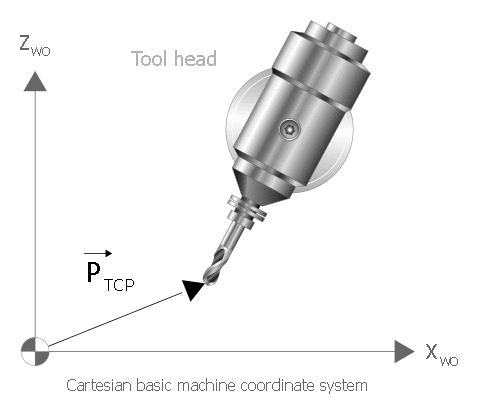Activation of TCP display data (P-CHAN-00145)
P-CHAN-00145 | Activation of TCP display data |
Description | This parameter is used to activate W0 display data (TCP position referred to the Cartesian basic coordinate system of the machine - MCS). The TCP position is calculated dependent on the active kinematic ID based on the current command axis coordinates, the selected tool (length) and the kinematic offset parameters. The calculation also takes place when transformation is inactive. All axes in the kinematic structure must exist in the channel.
|
Parameter | kin_trafo_display |
Data type | UNS16 |
Data range | 0: MCS display function inactive (default) 1: MCS display function active 2: MCS display function active (only for multistep transformation, see Addendum) |
Dimension | ---- |
Default value | 0 |
Remarks | The axes must be homed to obtain the correct display. Programmed tool offsets (V.G.WZ_AKT.V.*) are only considered if they are followed by the programming of #KIN ID[<kinematic-ID>]. Note: As of CNC Build V3.1.3105 the data type of the parameter changed from BOOLEAN to UNS16. |
Additions for multi-step kinematic transformations
A kinematic step can be defined in the parameter lists or in the NC program. A kinematic step is activated by programming the NC command #TRAFO ON.
For multi-step transformations see Concatenating transformations, multistep transformations.
Data value 0 (default):
Kinematic transformations are only executed to display axis positions if they are activated.
| PCS not active | PCS active |
Kin. step 0 = defined, Kin. step 1 = defined | MCS = ACS | MCS = ACS PCS = f(ACS, CSactive) |
Kin. step 0 = active, Kin. step 1 = defined | MCS = f(kin. step 0) | MCS = f(kin. step 0) PCS = f(MCS, CSactive) |
Kin. step 0 = defined, Kin. step 1 = active | MCS = f(kin. step 1) | MCS = f(kin. step 1) PCS = f(MCS, CSactive) |
Kin. step 0 = active, Kin. step 1 = active | MCS = f(kin. step 0, kin. step 1) | MCS = f(kin. step 0, kin. step 1) PCS = f(MCS, CSactive) |
Data value 1:
Kinematic transformations are always executed to display axis positions as soon as they are activated. Defined Cartesian transformations are executed for display based on the axis coordinates.
| PCS not active | PCS active |
Kin. step 0 = defined, Kin. step 1 = defined | MCS = f(kin. step 0, kin. step 1) | MCS = f(kin. step 0, kin. step 1) PCS = f(ACS, CSdef) |
Kin. step 0 = active, Kin. step 1 = defined | MCS = f(kin. step 0, kin. step 1) | MCS = f(kin. step 0, kin. step 1) PCS = f(ACS, CSdef) |
Kin. step 0 = defined, Kin. step 1 = active | MCS = f(kin. step 0, kin. step 1) | MCS = f(kin. step 0, kin. step 1) PCS = f(ACS, CSdef) |
Kin. step 0 = active, Kin. step 1 = active | MCS = f(kin. step 0, kin. step 1) | MCS = f(kin. step 0, kin. step 1) PCS = f(ACS, CSdef) |
Data value 2:
Kinematic transformations are always executed to display axis positions as soon as they are activated. Defined Cartesian transformations are executed for display based on the TCP coordinates.
| PCS not active | PCS active |
Kin. step 0 = defined, Kin. step 1 = defined | MCS = f(kin. step 0, kin. step 1) | MCS = f(kin. step 0, kin. step 1) PCS = f(MCS, CSdef) |
Kin. kin. step 0 = active, Kin. kin. step 1 = defined | MCS = f(kin. step 0, kin. step 1) | MCS = f(kin. step 0, kin. step 1) PCS = f(MCS, CSdef) |
Kin. kin. step 0 = defined, Kin. kin. step 1 = active | MCS = f(kin. step 0, kin. step 1) | MCS = f(kin. step 0, kin. step 1) PCS = f(MCS, CSdef) |
Kin. kin. step 0 = active, Kin. kin. step 1 = active | MCS = f(kin. step 0, kin. step 1) | MCS = f(kin. step 0, kin. step 1) PCS = f(MCS, CSdef) |
